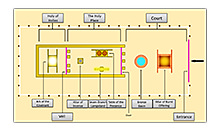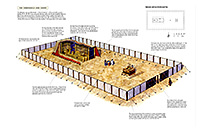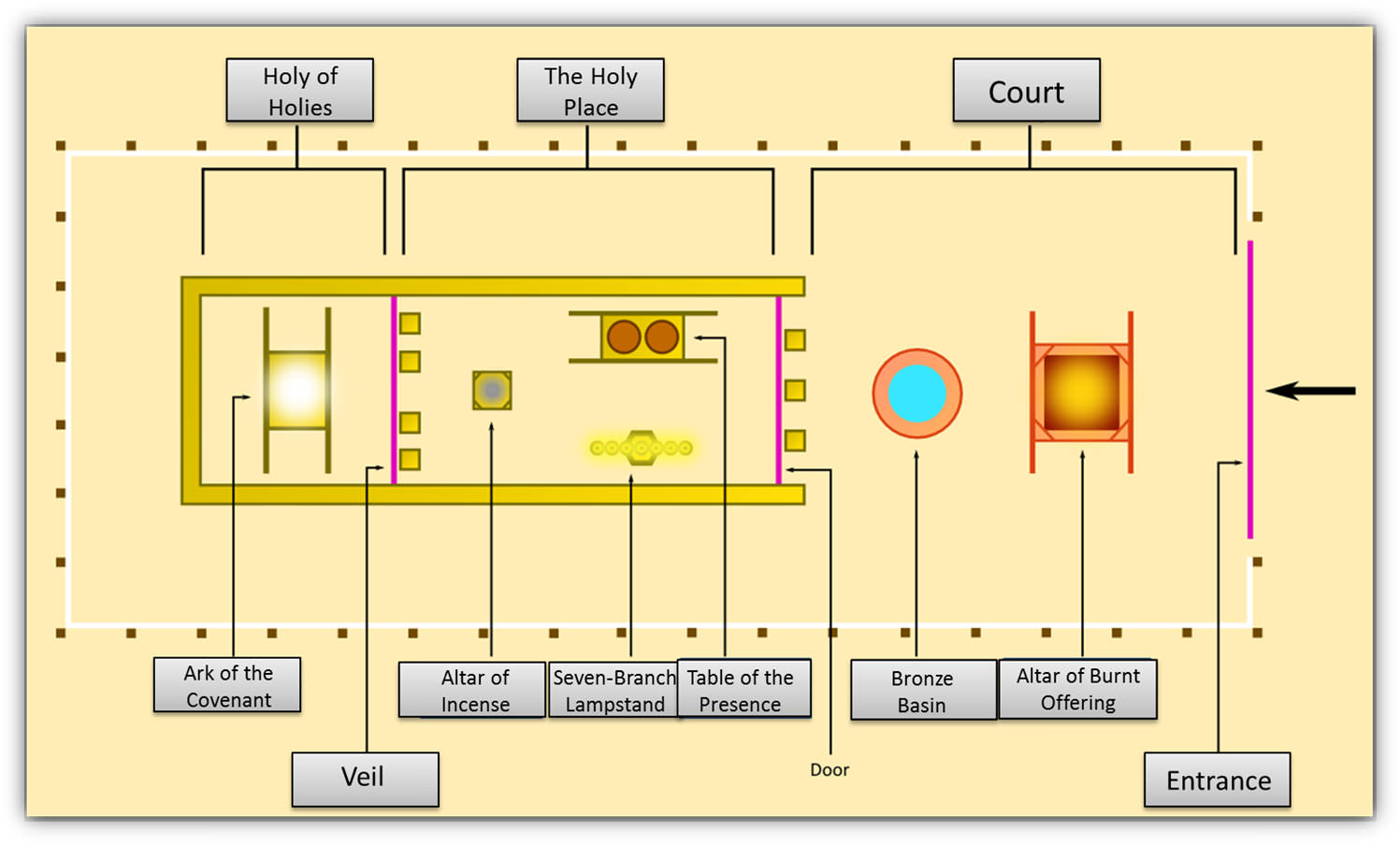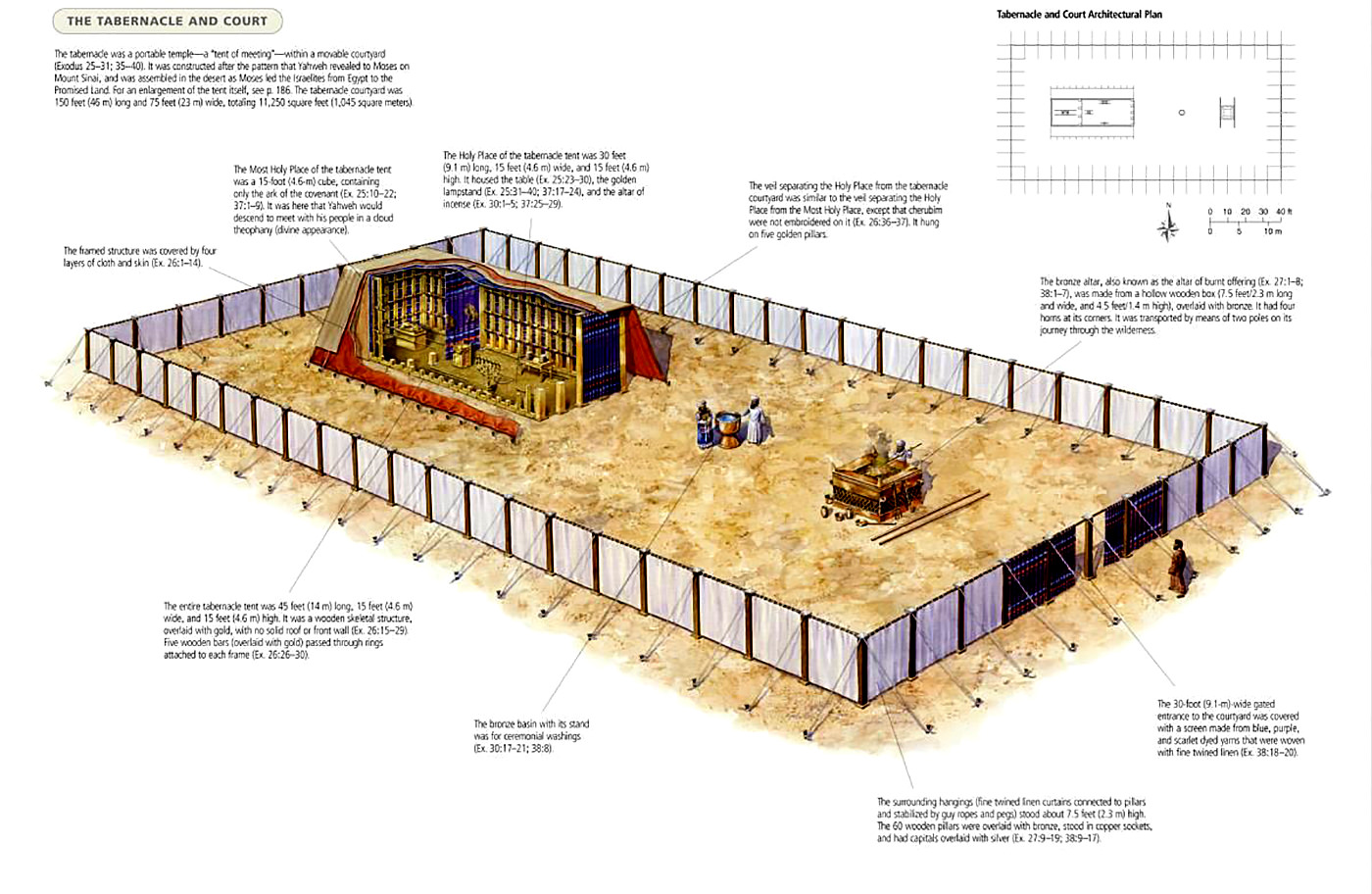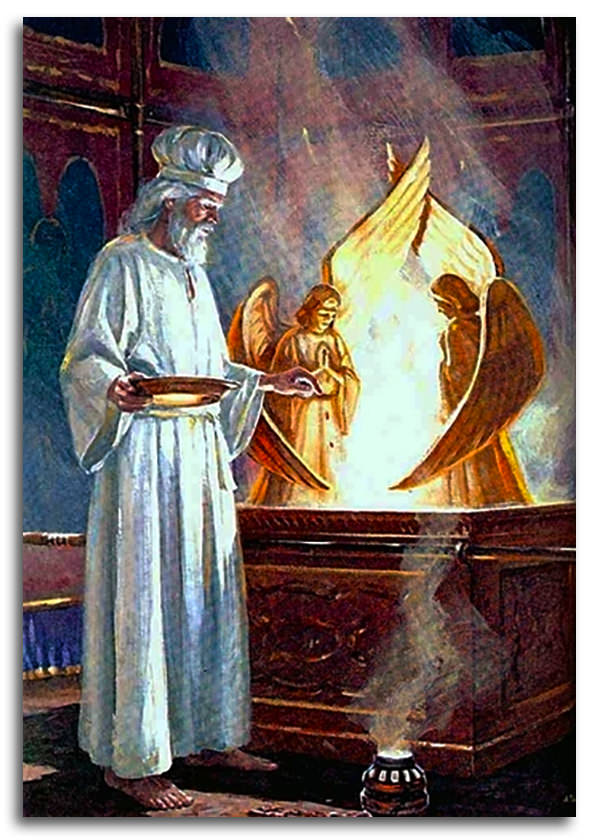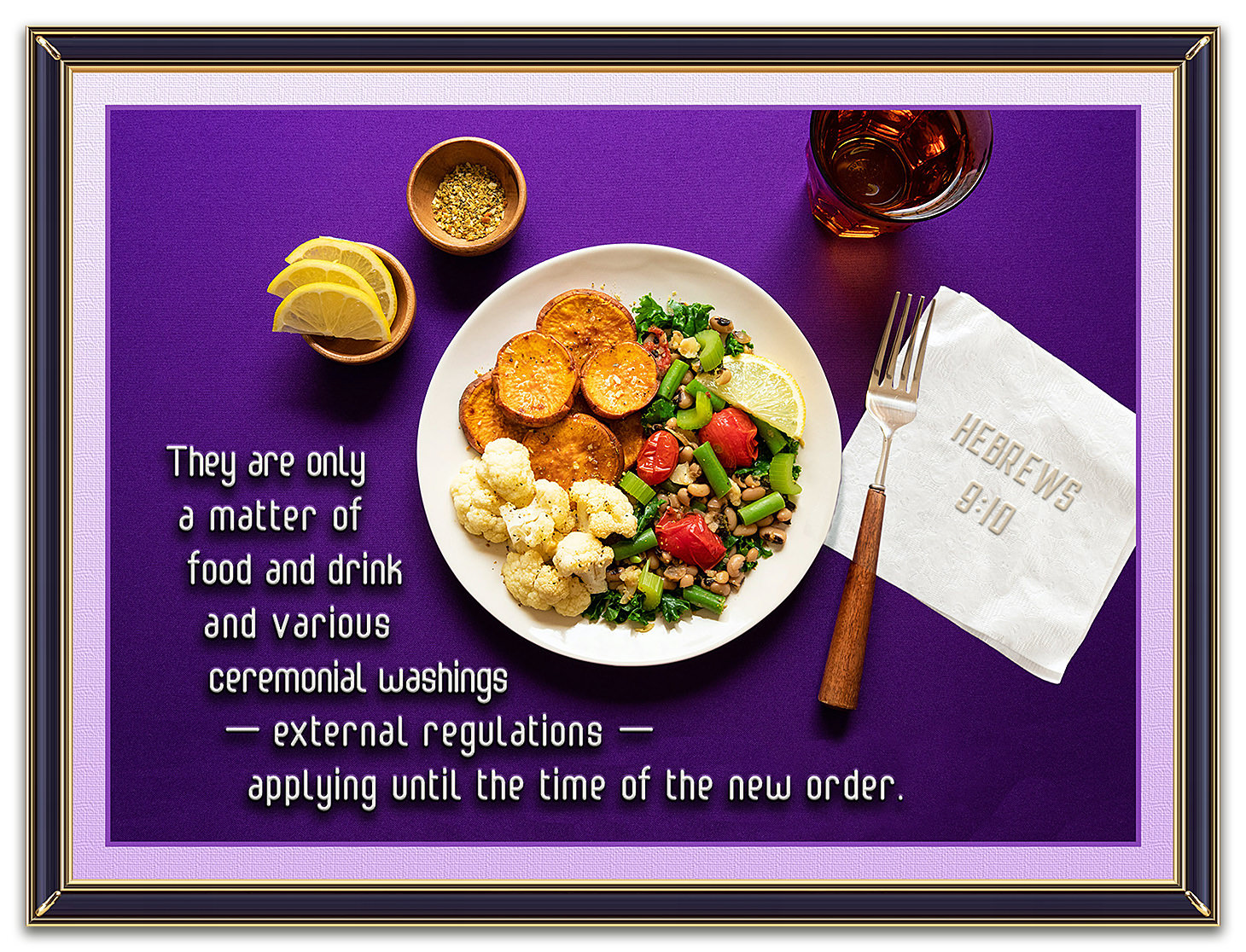Hebrews 9:1–10 . . .
“Worship in the Earthly Tabernacle”
The old covenant was mediated by sinful priests in an earthly tabernacle. It wasn't sufficient to heal the broken relationship between God and man. Today's passage refers to the desert's tabernacle that Moses had created, according to Father God's pattern, shown to Moses on Mount Sinai. The author apparently perceived the temple structure as being an end-product of the early tabernacle, since it was to be the Israelites' primary worship venue. God warned Moses to not deviate his construction of the tabernacle the tiniest bit because everything about the structure and its furnishings was intended to serve as a teaching tool to convey the importance of the truth of God's Word.
Today's 10-verse text explains how the chambers and artifacts of the tented tabernacle were meant as symbols only, specifically intended to show how the old covenant couldn't remove the barrier between God and man. The external rituals of this covenant could only soothe or suppress feelings of guilt; they were unable to remove one's sin or change a person's nature. After introducing in v. 1 the first covenant's regulations for worship in its earthly sanctuary, in vv. 2–5 the author will talk about the physical makeup of the Old Testament tabernacle in summary fashion. In vv. 6–10 he'll talk about how the high priest was to function within that tabernacle system.
Detailed Furnishings Inside the Earthly Sanctuary (9:1–5)
The author starts chapter 9 by calling attention to the furnishings of the inner and outer chambers of the tabernacle. That first covenant contained directions for divine worship in a specially designed place of worship: a large outer worship sanctuary.
Worship, in the Earthly Tabernacle"
1Now the first covenant had regulations for worship and also an earthly sanctuary. 2A tabernacle was set up. In its first room were the lampstand and the table with its consecrated bread; this was called the Holy Place. 3Behind the second curtain was a room called the Most Holy Place, 4which had the golden altar of incense and the gold-covered ark of the covenant. This ark contained the gold jar of manna, Aaron’s staff that had budded, and the stone tablets of the covenant. 5Above the ark were the cherubim of the Glory, overshadowing the atonement cover. But we cannot discuss these things in detail now (9:1–5).
This passage begins by describing in summary fashion the old covenant's tabernacle, including the worship furnishings in the inner and outer chambers. When we read at the end of v. 5, "we cannot discuss these things in detail now," clearly the Jews were familiar with the Old Testament tabernacle's details. This compartmentalization of furnishings is relevant to today's believers because it illustrates the eternal truths, as seen by Moses, that were associated with Christ's new covenant and his priesthood.
For us to correctly understand the new covenant and its priesthood, we must be diligent in our investigation of the tabernacle's structure, furnishings, and especially its accompanying rituals. The author provided a detailed understanding of these so that his audience, made up primary of Christians from Jewish backgrounds, could recognize the many great advantages of the new covenant's ministry. We believers are also obliged to identify and be grateful for the new covenant's numerous benefits and blessings today.
See the artistic plan view (left) and the perspective rendering view (right) of the earthly tabernacle and its essential components, as specified in Exodus.
Click each image to enlarge and print.
As per details found in Exod. 25 through 38, the earthly tabernacle of the Old Testament was planned by God for his earthly worship. It was erected within a large outdoor, walled-in edifice having three distinct parts: (1) an outer court that the Israelites entered via a single, 35-foot-wide gate that opened to an immediate viewing of a bronze altar of sacrifice that had a horn at each of its four corners. Behind the altar of burnt offering was a brass washbasin with which the priests cleansed themselves and their garments. The courtyard was as close as the average Israelite could get to God. The tabernacle tent itself, a 45-foot-long, rectangular framed structure, covered with four layers of cloth and skins — it was divided into two chambers (detailed below), (2) the Holy Place and (3) the Most Holy Place; each separated from the other by a thick curtain or veil.
The existence of the curtains in the Old Testament's earthly tabernacle, separating man from both holy places, was symbolic of how the old covenant represented barriers that kept the Israelites apart from God. This sets up a comparison, in the following passage, showing how Christ's sacrifice successfully performed true salvation, once for all, while it also achieved the perfection of our relationship with God.
The Holy Place: The first tabernacle chamber or inner room, called the Holy Place, was 15 feet wide, 30 feet long, and 15 feet high. Inside it were: an acacia-wood table covered with gold; a golden lampstand (the Menorah) having seven branches; and the altar of incense that had been made of acacia wood covered with gold. It was a virtual beehive of activity on a day-to-day basis.
On the gold-plated table, twelve freshly baked loaves were placed every Sabbath. The nearby lampstand, made of pure gold, was the tabernacle's only light source, positioned near the table of consecrated show bread. Beyond the table and lampstand was the golden altar of incense that priests used to burn sweet-smelling thyme to prevent the sanctuary from stinking from extensive amounts of animal blood poured continually during sacrifices.
The Most Holy Place: A thick veil at the rear of the Holy Place separated that chamber from the second one, which was a small cube of 15 feet, called the Most Holy Place (more literally, the Hebrew idiom "Holy of Holies"). It contained only the gold-colored ark of the covenant, a chest that represented God's dwelling place wherein Yahweh would descend to meet his people in a cloud or glowing light that rested between the cherubim above the ark. Inside the ark, beneath its gold lid (Hebrew kaporeth or "mercy seat") were Israel's three most-treasured possessions: (1) the gold jar of manna that never spoiled (Exod. 16:32); (2) Aaron's staff that budded and blossomed when leaders of other tribes challenged his priesthood (Numbers 17:6–11); and (3) the actual stone covenant tablets of the Law (Exod. 25:16), which Moses had brought down from the mountain, both of which had been etched by Father God's finger (Exod. 32:15).
Clarification While the NIV text states in vv. 3–4 that a golden altar of incense was located inside the Most Holy Place, several Bible versions (Darby, KJV, NKJV, Weymouth, Young's Literal, etc.) translate the Greek word thumiasterion more accurately as a hand-held censer, not the fabricated altar of incense. Strictly speaking in secular usage, thumiasterion described "a utensil or container for burning incense." It appears therefore that the act that the author was describing by using thumiasterion was the priest's putting coals of fire from the Holy Place's incense altar into the hand-held censor that he'd gotten from the Holy of Holies, then placing it near the ark's mercy seat, once each year on the Day of Atonement, as portrayed in this image.
To better understand both "holy places," let's first understand the concept of "holy." At its most basic meaning, holy simply means "set apart," even "different." God is holy because he's absolutely different, completely set apart from everything else. He's totally different from all things called "gods" while also completely set apart from sin, which is likely the impression that most people make about God’s holiness.
The three elements inside the ark served as lasting reminders for the Israelites: The manna evoked God's grace and the countless provisions that his people failed to appreciate; Aaron’s rod reminded God's children of their repeated refusals to follow God’s authority; and the two stone covenant tablets served to remind the nation Israel of its persistent failure to obey the Ten Commandments and the remainder of Mosaic Law.
Saint Thomas Aquinas wrote this to describe the magnificence of the ark of the covenant: "Then, over the ark were two cherubim, facing each other, who touched one another with two wings and touched the two sides of the tabernacle with the other two. Between the two wings, with which they touched each other, was a golden table of the same length and width as the ark, namely, two cubits in length and a cubit and a half in width, overshadowing the mercy seat. Hence, it served as a throne from which God would listen… Then the priest filled a censer with thyme, so that from the smoke ascended a cloud that covered the holy of holies, so that it would not be seen by anyone outside."
David Guzik — commentator and pastor — writes this about ark's atonement cover (v. 5): "The mercy seat was the ornate 'lid' for the ark of the covenant, made with the designs of cherubim upon it. The blood of sacrifice was sprinkled upon it for the forgiveness of Israel’s sin on the Day of Atonement (Exod. 25:17–22). As God looked down into the ark, He saw three symbols of Israel’s sin, rebellion, and failure. But when the blood of sacrifice was applied to the lid, the blood of sacrifice covered His sight of Israel's sin."
There's no doubt that this tabernacle and its furnishings would have been spectacular. Made precisely according to divinely revealed specifications and dimensions, everything about it and inside it had been fashioned by craftsmen who'd been gifted supernaturally, enabling each to create superb masterpieces. And don't forget that many of these magnificent ornate furnishings were either solid gold or plated with gold!
The Way into the Most Holy Place (vv. 6–8)
Verses 6–10 concentrate on the procedural functionality of tabernacle worship and the message that the Holy Spirit wants us to learn from our new covenant's worship.
6When everything had been arranged like this, the priests entered regularly into the outer room to carry on their ministry. 7But only the high priest entered the inner room, and that only once a year, and never without blood, which he offered for himself and for the sins the people had committed in ignorance. 8The Holy Spirit was showing by this that the way into the Most Holy Place had not yet been disclosed as long as the first tabernacle was still functioning (9:6–8).
Verse 6 moves from describing the items used in the temple to explaining how they were used. It sets up an important comparison: All the old covenant's furnishings and rituals were meant to symbolize God's promised ultimate, future, eternal covenant. Later in this chapter, and in this video by BibleProject, we'll see how Jesus' actions as our Great High Priest fulfills such symbolism.
After everything had been set up in the tabernacle, priests went about their duties in the large tent. Only the high priest entered the tent's smaller, inside room, then only once a year on the great Day of Atonement, offering a blood sacrifice for his sins and the people’s collective sins (v. 7). But the thick curtain separating the Holy Place from the outer court (shown in the two images above) symbolized man's separation from God, which exemplified the old covenant's inherent weakness. [Note: "covenant" appears twenty times in "Hebrews," more frequently than in any other book of the Bible. On Warren's custom graphic are all of the verses in which "covenant" appears.]
And at the rear of this Holy Place was a second curtain, blocking access to the most exclusive room, the Most Holy Place, the area into which only the high priest could enter, at a precise time, once every year, for a specific reason, with a designated sacrifice. The author carefully maintained that God's old covenant wasn't "wrong" but simply "imperfect" (7:11; 8:7). We should realize that this letter has deliberately decreed that this new covenant through Christ Jesus has always been God's ultimate plan for his people.
Why was it necessary that the high priest do the same sacrifice each and every year? We find the answer in v. 8: "the way into the Most Holy Place had not yet been disclosed." Here we're shown the Holy Spirit’s way of revealing that, so long as the large tent remains their sanctuary, people can’t simply walk in on God by entering his Most Holy Place.
Awaiting the New Order (vv. 9–10)
9This is an illustration for the present time, indicating that the gifts and sacrifices being offered were not able to clear the conscience of the worshiper. 10They are only a matter of food and drink and various ceremonial washings — external regulations applying until the time of the new order (9:9–10).
Here in v. 9, our author comments about how this "man separated from God" arrangement, with its path to the holy places curtained off, was symbolic of the "present time." The main idea is that those sacrifices offered under the old covenant were made following purely "external regulations." While physical rituals could temporarily soothe a participant's conscience (1 Peter 3:21), they couldn't possibly "clear the conscience" of worshipers. In order to make complete and successful cleansing, something more than external rituals and applications was required.
To be clear, we've been told, "the gifts and sacrifices being offered were not able to clear the conscience of the worshiper." In other words, no perfection or remission of sins was attained in this process. Note the fascinating declaration in v. 10 regarding the appropriate time for the termination of those sacrifices made in that Old Testament tabernacle when it was specified, "until the time of the new order." The Greek word used for "new order" (diorthosis) is used in the New Testament only here; it means "to set straight." That likely refers to the moment the new covenant took effect with the sacrificial death of Jesus Christ on the cross and finally set things straight.
Under this old system, gifts and sacrifices couldn’t effectively get to the heart of the matter and were unable to alleviate people's consciences when they were limited to matters of ritual and behavior. Essentially, the old system of sacrifice was a temporary arrangement lasting only until a complete overhaul would be made.
Aquinas asks and answers this question: "Why did the sacrificial rituals not cleanse the conscience? Because they consisted only in food and drink. What is altogether corporeal does not cleanse the soul because it does not act on the soul and can't cleanse the conscience… The Apostle calls those ceremonies regulations for the body, i.e., fleshly; they pertained only to bodily cleanness, and there was no spiritual power in them."
Clearly, the ultimate purpose of the old covenant tha regulated sacrifices externally was merely ceremonial, able only to relieve worshipers' consciences until God introduced his new covenant through Lord Jesus' priesthood. Throughout "Hebrews" we're shown that God never intended to keep the old covenant perpetually. He instead distinctly promised a superior, more complete structure. As a result, the old covenant's imperfect external rituals were replaced by a perfect, dedicated, productive salvation opportunity, which only Jesus Christ, "in the new order," had the capacity to offer his people.
The three synoptic gospels report that, when Jesus died on the cross, the curtain of Jerusalem's temple — that barrier between the Holy Place and Most Holy Place — was supernaturally torn in two (see Matthew 27:51; Mark 15:38; and Luke 23:45). That split curtain symbolized that, in "the new order," animals' blood would no longer be needed. Thankfully, personal access to God is now available to everyone, through Christ's death.
- Q. 1 What didn't happen here at this time (vv. 8–9)?
- Q. 2 When you feel guilty of sin, how do you try to clear your conscience? . . . Does it work?
Hebrews 9:1–10
New International Version (NIV) or view it in a different version by clicking here.
— Listen to chapter 9, narrated by Max McLean.
